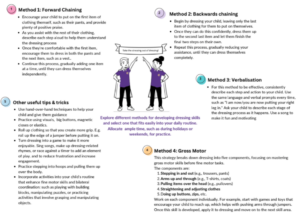
Some children may struggle with having their nails trimmed, often due to hypersensitivity to touch or noise, making the experience feel overwhelming. This can cause distress for both the child and the parent, turning this routine task into a stressful experience.
To help your child feel more comfortable and better manage their sensory challenges, here are some practical tips to set them up for success during nail trimming.
See link here:
Stress free snips.pdfNail trimming social story.pdf
Brushing teeth is an essential skill for children to learn as it fosters self-care and independence. Developing proper dental hygiene habits early on encourages children to take responsibility for their own health and well-being. Learning to brush their teeth correctly helps prevent cavities and gum disease, ensuring a healthy smile and reducing the need for dental treatments. This routine also teaches children the importance of daily self-care, building a foundation for other personal hygiene practices. As they master this skill, children gain confidence in their ability to manage their own needs, promoting a sense of independence and self-reliance that benefits them in many areas of life.
Check out the excellent Pokémon Smile app, available for free on smartphones. This engaging and motivating app is designed to help children brush their teeth more effectively and independently. By turning brushing into a fun and interactive game, Pokémon Smile encourages kids to develop and maintain good dental hygiene habits. As they brush, children can “catch” Pokémon, making the experience enjoyable and rewarding. The app provides visual and verbal cues to guide proper brushing techniques, ensuring thorough cleaning while fostering self-sufficiency. It’s a fantastic tool for parents seeking to make toothbrushing a positive and consistent part of their child’s daily routine.
Learning to dress independently is an essential life skill that promotes confidence, independence, responsibility and fine motor development in children. Mastering this skill can be particularly challenging yet empowering. Once mastered, it can help make the stress of getting ready for school in the morning and out of the house on time that much more successful! Here are practical strategies, visuals and tips to guide you through the process of teaching your child how to dress themselves.
Click on the images below to see some of our own ‘Take the stress out of dressing resources’
Learning how to tie shoelaces can be challenging but it is an important self-care skill for your child to learn! It is an important skill to master for many reasons including, teaching your child important skills like following directions, sorting, sequencing, planning, hand-eye coordination and midline crossing. Developing this skill will also help your child to develop their dexterity and independence.
Here are some tips to help when teaching your child how to tie shoelaces.
- Start with your child sitting at a table, practising with a shoe on the table in front of them. Once your child is able to independently complete all stages of tying a shoelace on a shoe on a table in front of them, they can then move on to practising with the shoe on their foot.
- Teach your child how to untie their laces first. This is easier.
- Physically help your child, placing your hands over theirs and gradually reduce the physical support as they begin to gain confidence.
- Use backward chaining. Start by breaking the task down into small steps. You teach your child the last step first, working backward from the goal. The adult completes all the steps except the last one. Get your child to practise the final step. Your child will enjoy the success that comes from completing a task. Once your child can do the last step you complete all the steps except for the last two. You teach your child the second from last step and they then complete the last step themselves. Keep going until you are teaching the first step and your child is completing all the other steps.
- Provide lots of praise and encouragement.
- If your child is struggling, you may be attempted to take over, but please don’t. Provide lots of encouragement and give them the time they need to practise!
- Often, children find it useful to practise using two different coloured laces to help identify the laces clearly.
There are many step-by-step videos you can watch with your child. You can pause these at any time so your child can do the step immediately after watching it. There are also step-by-step visual guides that are really useful to use. Below is a video, plus a link to a resource that we think is really helpful.
Many children find it difficult to achieve independence in toileting and this skill can be even more difficult when the child has ASD and sensory processing issues. Patience and practice are key!! Independent toileting is a very complex task with lots of steps. An important strategy we use when supporting toileting skills is ‘backward changing’. This strategy provides children with a sense of achievement and enables the skill to be broken down into achievable steps. Here is a link to a really useful website further explaining the backwards-changing approach and information on supporting your child to become independent with toileting.
These videos are excellent for early language development. They are very engaging for children and model important early language and concepts. This is useful for early years children who need support with their spoken language. Below is one of her videos but you can find the whole channel here.
Great sign-along stories made especially for SEN schools.
Learning to ride a bike tips & tricks

Balancing:
- Supporting balance is important to teach as a separate skill from learning to pedal.
- Encourage children to scoot along using their feet to push against the ground. This way you are breaking the task of balancing down.
- Use a scooter- this allows the child to isolate the skill of balancing two feet on the scooter deck (when gliding).
- Children need to be going fast enough on the bike/scooter, so you can incorporate a game to encourage a “gliding” movement
Eg. The floor is lava game, use chalk to draw lines on the ground and instruct your child to not touch the lines (picking up their feet over the chalk lines), Follow the leader or simple obstacle courses on bikes, trikes or scooters.
- Have your child practice safely putting their feet on the ground to avoid falling. Our goal is to develop a “self-protection” reflex, where children will recognise their change in equilibrium and catch themselves when they experience a disruption in balance.
Walking with the bike:
- Support walking along in a straight line whilst holding onto the handle- bars, with the bike on their right-hand side. When they can do this, teach them to use both brakes to stop the bike suddenly on command.
- Whilst still walking beside the bike and not yet riding on it, teach your child how to turn corners (using plenty of space). This will help them begin to learn how to handle and steer the bike, and how the weight of the bike is distributed and managed.
Pedalling:
- Teach your child to kick the pedals into position ready for push off, with their preferred foot just forward of the highest position to get good leverage.
- It may also help to get the child to lay on the floor on their back and practise the pedalling action with their feet in the air so they understand the action required.
Riding:
- Whilst scooting along and building balance skills, repeat the same stages of learning as before when learning to walk beside the bike – first learn to go in straight lines and to use the brakes well, and then to turn corners.
- Hold the back of the seat to give some help with balance at first as the child gets used to pedalling whilst balancing. If you can use two adults, one each side if the child really struggles with balance.
- You will gradually feel your child managing to balance without your help.
- As they pedal and gradually release your grip to allow them to feel their body adjusting to the fading support.
Surfaces to practise on:
- For some children, practising on a smooth, flat surface (such as the concrete) is preferred because it makes pedalling a bit easier (requiring less strength or force).
- For others, pedalling on a flat grassy surface, although it may require more strength to pedal, it can provide them with more proprioceptive feedback (resistance that is recognised by joints and muscles) so their body can better understand the motion.




